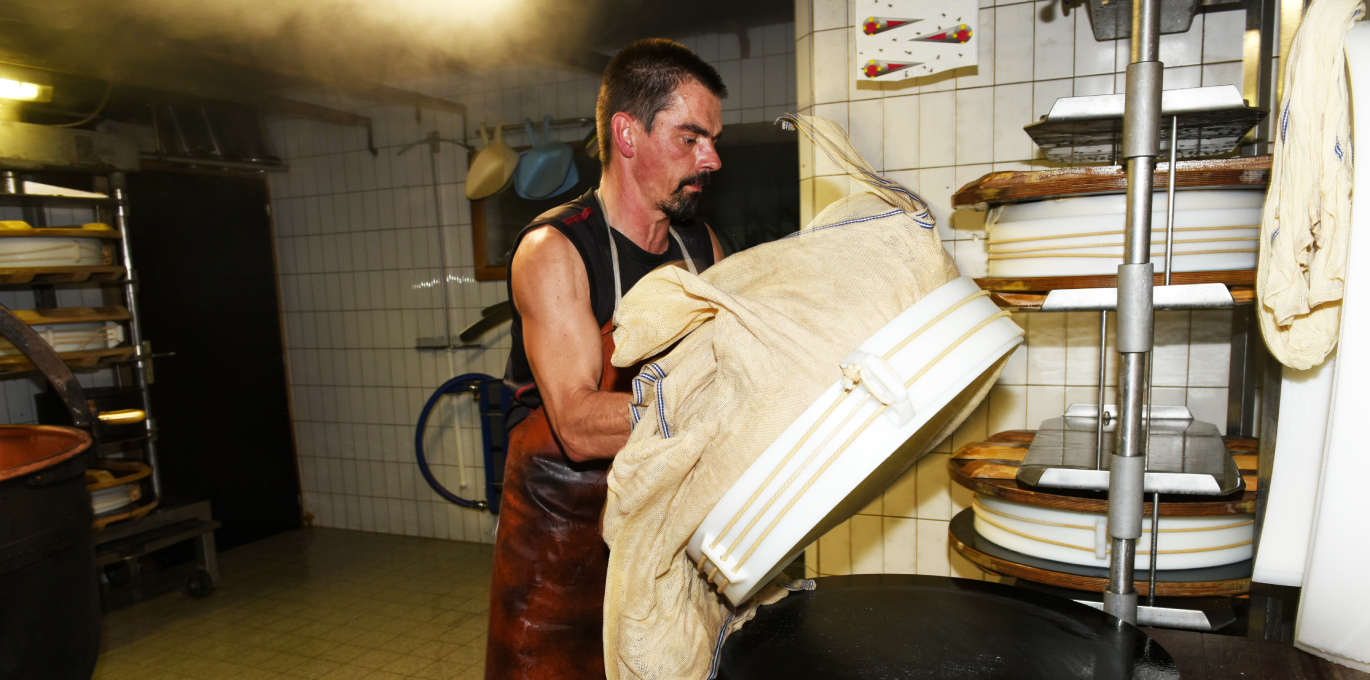Milk producers

There are more than 1,800 milk producers who deliver the milk needed for the production of Gruyère AOP to a specific cheese dairy twice a day, morning and evening. On average, a dairy farmer has between 30 and 50 dairy cows.
The dairy farmers are the guardians of the raw material of Gruyère AOP. Their experience, competence, their love of the land and their herd contribute to the production of high-quality milk. Milk for Gruyère AOP comes only from cows fed on grass in the summer and hay in the winter – essentially grown in the region. The milk used for the production of Gruyère AOP is raw milk. In this way it keeps all its flavours as well as its nutritional values.
The dairy farmers get up every day of the week at dawn to feed and milk their cows. They then coordinate the transport of the morning milk to the cheese dairy. During the day, they take care of all their various tasks consisting of, among other things, looking after their herd. At the end of the day, they restart the process of milking and delivering the evening milk which will be added to the next day’s milk to make the Gruyère AOP.
The cheesemakers

There are more than 160 Gruyère AOP cheese dairies. The cheesemakers use their traditional know-how to turn the milk they receive each day into cheese wheels.
The cheesemakers are masters of their domain – each completes four years of specialized schooling to become “cheese masters”. Without their knowledge, experience, and skill, Gruyère AOP would be a completely different product.
The cheesemakers often work 7 days a week - many of them along with their wife - to produce Gruyère AOP. They sometimes have a small number of employees so they can have a few days off.
They begin their day at 5 in the morning, and finish the production in the middle of the day. They care for the Gruyère AOP as it matures in their cellars. At the end of the day, they take care of the arriving milk which usually comes around 7 in the evening.
After 3 months in the cheesemaker’s own cellar, the Gruyère AOP is delivered to a refining company.
Alpine cheesemakers

Over the summer period from May to the start of October, about 50 alpine pastures make Gruyère d’Alpage AOP. The whole process takes place at the mountain pasture: the herd graze around the chalet where the cheese is produced and the evening and morning milk is combined to make the cheese on-site. A wood fire is used to heat the milk and the wheel is pressed using a cloth. Next, the affineur takes charge of the wheel so it can undergo the same journey as its sisters from the village dairies. Alpine production, with its ancestral roots, relies on the considerable know-how of the family farming structures in place.
The affineurs

There are 11 Gruyère AOP affineurs. The affineur takes care of the Gruyère AOP for several months. They know how to choose the best wheels for making more characterful varieties. The Gruyère AOP must be aged for at least 5 months before it can be released on the market.
The wheels are in the hands of the master refiners for months. They are cared for in humid caves which help develop their inimitable character. The process takes place at a temperature of between 12 and 18 degrees celsius, with a relative humidity of about 92%. While each wheel is cured, it is regularly turned and cared for with salted water. This not only protects the qualities of Gruyère AOP, but also allows it to travel around the world to reach our loyal customers.
Every wheel of Gruyère AOP is unique. The weather, the geographical location of the farm, the cheese dairy, the know-how of the cheese-maker and the refiner. As a result, these differences can all subtly influence the process. The atmosphere in Gruyère AOP cellars diffuses a light smell of ammonia - a sign of healthy cheese maturation. Some wheels will be at their best at 6 months, and some others at 16 months. The affineur must therefore use his experience to fully exploit the potential of each individual wheel.
The affineur uses all of his senses to ensure that each piece of Gruyère AOP is at its very best for the consumer.
